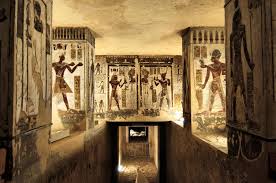
Unfortunately, the tomb of the great Pharaoh Ramses II is unsuitable for visiting by tourists. It was one of the first tombs to be dug near the entrance of the Valley of the Kings, but King Ramses II perhaps chose one of the worst places for his tomb, which has seen no less than seven flooding events. Tomb KV 7 is one of the largest tombs in the Valley. It covers 686 square meters and extends 168 meters into the hillside. Some scholars believe that he began its construction during the second year of his reign with a plan that belongs to the right-angled layout of the royal tombs of the Eighteenth Dynasty. This tomb has never been systematically cleared. Some of the many archaeologists and explorers who have worked on clearing the Tomb of Ramses II are: Henry Salt (around 1817), Champollion and Rosellini, Lepsius, Harry Burton, Theodore Davis (between 1913 and 1914), and Howard Carter (who cleaned up the entrance between 1917 and 1921). All of these explorers, but the most recent, quickly abandoned the work. Since 1993, the French archaeologist Christian Leblanc has been working here, and his reports regularly announce important discoveries. There are still thousands of cubic meters of debris to clear away and substantial structural engineering to be done. So it is unlikely that Tomb KV 7 will be opened to the public any time soon. Excavations have found only a few objects in the tomb, probably because it was heavily robbed in antiquity. It was mentioned that during the twenty-ninth reigned year of Ramses III, thieves broke into the tomb, and for sure there were many other robberies as well.
The Decoration of the Tomb of Ramses II (KV 7)
The decoration of the Tomb of Ramses II is similar to that of the Tomb of Sety I. At the entrance and for the first time, we find a lintel with decorations of a solar disc flanked by Isis and Nephthys. Also In the doorway, we find scenes of Ma'at seated above heraldic plants of Egypt. The tomb was decorated, in both raised and painted relief and in painted plaster, but few of its damaged walls have been exposed for study. Corridor B was decorated with the Litany of Ra and texts in Corridor C are from Chapter 151 of the Book of the Dead. The Imydwat follows in Corridor D and well Chamber E. Then following are scenes and texts explaining the Opening of the Mouth ritual. The tomb's axis makes a right angle turn to the north in chamber I whose rear wall is covered with the Negative Confession, Chapter 125 of the Book of the Dead. In Burial Chamber J and its side chambers, we found the Imydwat and the Book of the Gates. Inside Chamber J, we can see the Book of the Heavenly Cow, which also is represented in a side chamber in the Tomb of Sety I.
